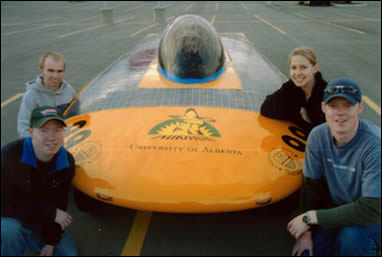|

______________________
BY RYAN B. LAWRENCE
University of Alberta
Student Contributor
______________________ |
 |
The sun is shining, classes are out and except for the occasional
May flurry, summer seems to be well on its way. For student
project leader Glen Rees and his team of engineering students,
there is no better time to turn up the heat in their current
design of the University of Alberta Solar Vehicle Project.
Since last September, the team has completely overhauled
its previous solar car design, the Inukshuk, and plans
to have the new model ready for competition in the summer
of 2005.
 |
Solar Trails
Inukshuk
and the team during the summer of 2003, when they went
from Edmonton to Nisku and
back. This exposed newer members to how the car handled
and helped direct design efforts.
|
How it Works
How does it work? Glen explains it this way.
First, you need sunlight. The sunlight’s photons hit
the solar cells on the car. Many solar cells are connected
together on the top of the vehicle body, forming modules.
There are five of these modules on the car and they are connected
in parallel to form the array.
Once the photons hit, electrons are released within the solar
cells and this produces a current. The solar cells are designed
to produce a certain voltage at all times. Based on this
voltage held in the solar cells and the current produced
from the released electrons, a certain amount of power is
produced.
The solar cells are connected to a battery via a power point
tracker to ensure maximum charging.
The batteries power two sections. The low voltage section
steps down the voltage of the battery to a usable amount
for the monitoring and safety electronics of the car. The
high voltage section runs 96 volts into the motor via a motor
controller which converts the DC voltage to usable AC.
From there, the car works much like a normal vehicle.
Big Design Changes
This new design promises to be the most ambitious the team
has taken on. Glen says that among the results will be
increased speed and efficiency.
The team wants to rectify is weight. The Inukshuk was over
designed because the first car, the Nanook, did not even
qualify. The Inukshuk was built to work, which overshadowed
other issues.
The team is changing from the original lead-acid batteries,
weighing 350 lb., to a lithium ion battery weighing 65 lb.
Extra monitoring will be necessary to keep the more finicky
battery stable, but the batteries are otherwise comparable
in performance. It’s a small price to pay for the weight
reduction.
A bigger, more efficient array of solar cells will deliver
more power to the battery. The Inukshuk array covered about
eight square metres of the car’s top, the new array
will cover about 10 square metres.
Each array is made up of solar cells 10 cm by 10 cm in size.
Efficiency increases to 20 per cent from 14 per cent. Currently
the greatest amount of efficiency that can be gained from
the best solar cells is about 32 per cent.
The motor will be the same as that of previous models: a
96-volt, DC brushless, 5 kW power engine operating at 95
per cent efficiency when running at 1,100 r.p.m. This motor
will propel the car, the team hopes, to speeds greater than
70 km/h and a top speed of 110km/h.
Cruising speed will use only power provided by the sun through
the solar cells, while top speed will require power to be
drawn from the battery.
Casing and Chassis
One section of car will be casing, covering the under parts
as well as providing an enclosed windshield. The array
sits atop the casing.
Then there’s the chassis. The Inukshuk had a “space
frame,” with the upper and lower components of the
car made separately and then put together at the end. The
new model will have a “semi-monocoque chassis,” including
the roll cage and exterior frame. This new chassis will be
made of composite materials to decrease weight.
An idea is in the works that would have the casing move up
from the chassis with the use of small hydraulics, like the
mouth of an animal opening.
The team is also looking at new features. A cruise control
option will be added to save on power – constant acceleration
and deceleration puts a lot of strain on the batteries. Further,
the team will be making the new car a two-seater, allowing
a passenger to ride along.
Plans for the Summer
The new car is being designed for the upcoming North American
Solar Challenge, which will start in Houston, Tex., run
north to Winnipeg, and finally carry on across the Prairies
to Calgary. The start is in mid-July 2005, and the race
is expected to take 10 days.
The solar team is currently in the design stage and hopes
to be building as of September 2004. This summer the team
hopes to gain partners in order to set up funds for the project.
The team will also be upgrading education presentations for
next year. Team members visit with students in Grades 4-12
to discuss alternative energy and the solar car.
Upcoming Events for the Team
You can see the team this summer at a few events in Edmonton.
On July 1, the team participates in Strathcona County’s
Canada Day celebration in Sherwood Park. The Inukshuk will
be there and the team will meet the public.
The team will be in the Klondike Days Parade, July 22 in
Edmonton.
Adopt-a-Cell Program
If you’d like to help sponsor the project in an affordable
way, the adopt-a-cell program may be for you. Adopt a solar
cell for $20 each or $50 for three. In return, your name
will be displayed on the vehicle website and sponsorship
banners.
You will also be invited to the official unveiling of the
new vehicle, and will receive a certificate acknowledging
your sponsorship and a photo of the team and the car.

On Adopt-A-Cell
And the
Solar Vehicle Project
E-mail Glen Rees at
grees@ualberta.ca or solarcar@ualberta.ca.

|




